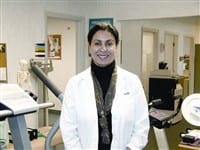Holistic Approach Dr. Raghu Bajwa Strives To Treat The Whole Person, Not Just Back Pain
For Dr. Raghu Bajwa, it’s all about “making people functional.”
That’s the reason patients come to the Center for Pain and Rehab Care in Springfield, where Bajwa, a physiatrist and physical medicine and rehab specialist, focuses on muscles and neural and non-surgical treatment and management of pain and injuries.
And that word management is key, she said, because rehabilitation doesn’t end outside the medical office door.
“We deal with pain management, sports injuries — making people functional after any disability or injury,” she said. “There are two parts: inpatient, where we take people with spinal or head injuries and help them become functional; and outpatient, after they’re discharged, when we do more pain management.”
That’s a more appealing concept to Bajwa than the field of general surgery in which she started her medical career — and she’s not alone, judging by the fact that physiatry continues strong growth nationally, with more than 6,000 practicing in the U.S. today.
Fork in the Road
Bajwa, who hails from India, began her medical career in general surgery at Columbia-Harlem Hospital in the 1980s, but she didn’t find the work as fulfilling as she thought it would be. By observing the work of physiatrists there, she saw a better career path for herself — and a different approach to treating limbs.
“We used to amputate on people,” she said. “But physiatrists would come and take the time with them to bring them back to normal and give them artificial legs. I was impressed. It was rewarding to see patients becoming more functional. I had four weeks vacation, so I took the time to learn more about rehab, and that’s how I became attracted to it.”
Physiatry — also known as physical medicine and rehabilitation — is a branch of medicine that specializes in diagnosis, treatment, and management of disease using ‘physical’ means, such as physical therapy and medications. Essentially, physiatrists specialize in non-surgical treatments for the musculoskeletal system, and many are essentially specialists in treating back pain.
“It’s a new field, about 50 years old,” Bajwa said. “It’s a branch from orthopedics combined with a branch from rheumatology and a branch from neurology. It’s a field where not one physician, but multiple people are working with a patient — a physical therapist working with the legs, an occupational therapist working with the arms, and a cognitive therapist working with the brain.”
Meanwhile, a physiatrist coordinates care. And Bajwa said one key is to see patients in a holistic way. “We look at them as a whole, not just a back.”
For example, a physiatrist must learn about a patient’s lifestyle in order to treat him or her properly. “Are they using proper body mechanics? Do they need to change their work station? Are they using the right weights?” Bajwa said. “We look at what we might change in their work situation so they use body mechanics properly.”
Fertile Ground
With so many factors contributing to back pain, it’s not surprising that treating it has become a field of opportunity — and a chance to educate patients, not just ease their pain, Bajwa said.
“The United States spends $16 billion on back pain every year, and it’s the second-most common cause of pain next to headaches. Most Americans have back pain at some point in their lifetime. For both men and women, depending on their bones, the way they work, arthritis, and other factors, it’s very common.”
Common enough, in fact, that different fields have learned to work together in tackling problems. Bajwa said she enjoys the interaction with other medical professionals in the region.
For example, “if a nerve is being pinched, once we diagnose it and know what’s going on, we can start therapy with patients, and I would say 95{06cf2b9696b159f874511d23dbc893eb1ac83014175ed30550cfff22781411e5} of the time they do get better,” she said. “In the other 5{06cf2b9696b159f874511d23dbc893eb1ac83014175ed30550cfff22781411e5}, if there is a disc problem and the therapy didn’t help, I’d recommend a neurosurgeon to look into it, or sometimes I send the patient to a pain clinic.”
Inpatient care has become more difficult in a field that stresses long-term care and management, especially since the time covered by insurance has gradually been reduced from 28 days to 12. “There’s often little we can do in 12 days for a stroke patient,” Bajwa said. “Sometimes it can take up to a year to show changes.”
Sometimes the biggest challenge, however, is simply keeping injured patients away from physically stressful situations before they’re ready. If they insist they need to return to heavy lifting, as it were, there’s only so much a doctor can do.
“I tell them how they can compensate in their muscles and ligaments and still get back to sports,” Bajwa said. “Or, some people can’t afford to be out of work because of financial reasons. In those cases, we can modify their work — call their employer and ask, ‘instead of lifting 50 pounds, can he lift 25 to 30 pounds?’ That way, they can have a gradual return to work.”
Of course, the workplace is one of the main places people develop back pain, which is why patients are referred to Bajwa not only from hospitals, but from attorneys seeking to weigh workers’ compensation claims.
Spreading the Word
As far as her own workplace is concerned, Bajwa began her Western Mass. career working with inpatients at Weldon Rehabilitation Hospital in Springfield before moving on to subacute care with Genesis Eldercare. Now that she’s been working at her own practice on Maple Street for several years, one of Bajwa’s main goals is simply to make more people aware of what physiatrists have to offer.
“When you tell people you’re a physiatrist, they think of podiatrist or psychiatrist,” she said.
She’ll gladly leave the foot care and mind therapy to other doctors. But when it comes to soothing back and muscle pain — and teaching patients how to manage those conditions on their own — Dr. Bajwa is definitely in.



Comments are closed.